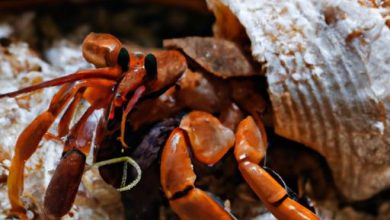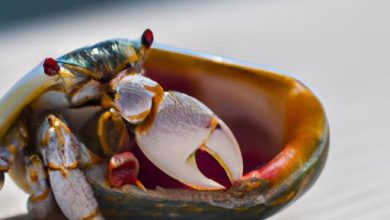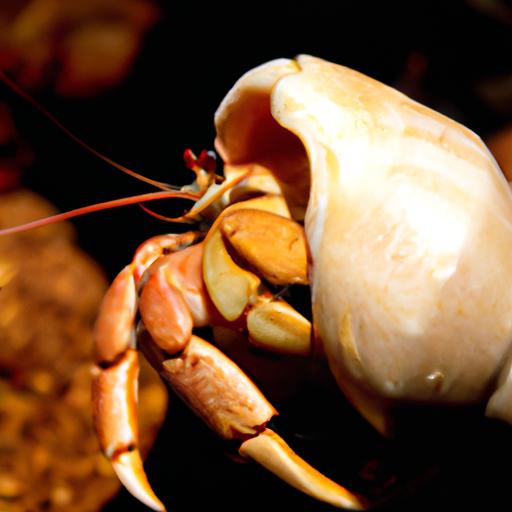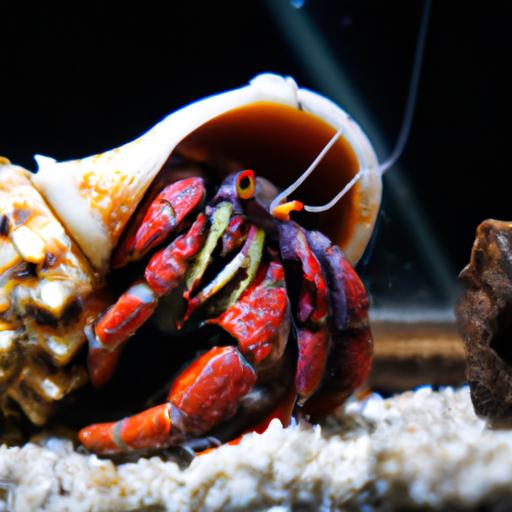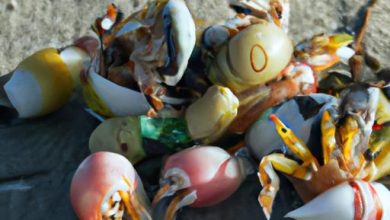How Do Hermit Crabs Drink: Unveiling the Secrets of Their Hydration
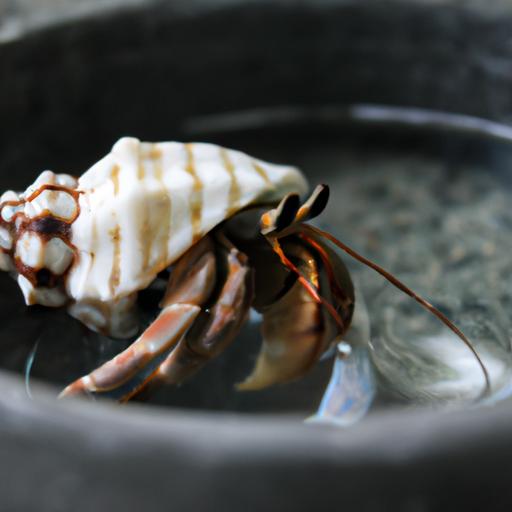
Hermit crabs, the tiny creatures that scuttle along sandy beaches, have long piqued our curiosity. With their unique shell homes and peculiar behaviors, these crustaceans never cease to amaze us. But have you ever wondered how hermit crabs quench their thirst? Join me on this fascinating journey as we explore the intricate ways hermit crabs hydrate themselves.
Introduction
As we delve into the world of hermit crabs, it’s crucial to grasp the significance of understanding their drinking habits. Just like any living organism, hermit crabs rely on water for their survival. However, their drinking mechanism differs from that of other creatures, making it an intriguing subject to explore.
A. Brief overview of hermit crabs
Hermit crabs, members of the crustacean family, are often found in coastal regions around the world. These small, soft-bodied creatures are known for their habit of dwelling in empty seashells, which they use as portable homes. Their unique adaptation allows them to change shells as they grow, ensuring a snug fit.
B. Importance of understanding how hermit crabs drink
Understanding how hermit crabs drink is vital for their proper care, whether you’re observing them in the wild or keeping them as pets. By unraveling the secrets of their hydration, we can provide optimal living conditions to ensure their well-being. So, let’s embark on this knowledge-filled journey and uncover how these fascinating creatures quench their thirst.
By grasping the intricacies of hermit crab hydration, we can gain valuable insights into their needs and enhance their welfare. Join me as we continue our exploration and delve into the anatomy of hermit crabs in section
Anatomy of a Hermit Crab
A. Description of Hermit Crab’s Body Structure
To understand how hermit crabs drink, we must first familiarize ourselves with their unique anatomy. These fascinating creatures possess a body structure that sets them apart from other crustaceans.
Hermit crabs have a soft, vulnerable abdomen that lacks a protective exoskeleton. To compensate for this vulnerability, they seek shelter in discarded shells, such as those left behind by snails. As they grow, hermit crabs must find larger shells to accommodate their increasing size.
B. Explanation of Their Modified Gills
Unlike fish, which use gills to extract oxygen from water, hermit crabs have evolved a modified set of gills. These gills are responsible not only for respiration but also for maintaining the crab’s hydration levels.
The modified gills of hermit crabs are located within their branchial chamber, which is situated at the base of their abdomen. These gills are specialized structures that enable the absorption of moisture from the surrounding environment. As hermit crabs breathe, their gills also extract moisture from the air, aiding in their hydration.
By adapting their gills to serve a dual purpose, hermit crabs have developed a mechanism to obtain water in addition to oxygen. This unique adaptation ensures their survival in both aquatic and terrestrial environments.
Now that we have explored the fascinating anatomy of hermit crabs, let’s move on to section III, where we will discover the various water sources that hermit crabs rely on for hydration.
Water Sources for Hermit Crabs
Hermit crabs, like all living organisms, require water for their survival. In this section, we will explore the various water sources that sustain these fascinating creatures, both in their natural habitats and in captivity.
A. Natural habitats and water availability
In the wild, hermit crabs inhabit coastal regions, where they have access to a variety of water sources. These include saltwater bodies such as oceans, seas, and estuaries. The proximity to these water sources is essential for their survival, as they need access to water for drinking, moisture regulation, and bathing.
B. Types of water hermit crabs can drink
Did you know that hermit crabs possess specialized modified gills that enable them to extract oxygen from the air? These unique gills also allow them to drink water. Hermit crabs have the ability to drink both freshwater and saltwater. However, they prefer a mixture of the two, as it closely mimics the conditions of their natural habitat.
C. Importance of providing clean water in captivity
For hermit crabs kept in captivity, it is crucial to provide them with clean, chlorine-free water. Tap water may contain harmful chemicals that can negatively impact their health. It is recommended to use dechlorinated or purified water to ensure the well-being of your hermit crab. Additionally, regularly changing the water and keeping their enclosure clean helps prevent the buildup of bacteria or other contaminants.
In the next section, we will uncover the fascinating drinking behavior of hermit crabs, shedding light on how they consume water. Are you curious to learn more? Let’s dive into section IV and quench our thirst for knowledge.
Drinking Behavior of Hermit Crabs
Hermit crabs have fascinating drinking behaviors that set them apart from other creatures. Let’s take a closer look at how they satisfy their hydration needs and the factors that influence their drinking behavior.
A. Overview of how hermit crabs drink
Unlike humans who use their mouths to drink, hermit crabs have a unique way of consuming water. They do not possess a specialized organ, like a mouth or a straw, to directly take in fluids. Instead, they rely on a process called “osmosis” to absorb water through their modified gills.
B. Explanation of their drinking mechanisms
To drink, hermit crabs submerge their modified gills in the water. These gills, located within their shell-protected abdomen, are responsible for both respiration and water absorption. Through osmosis, the gills extract water molecules from the surrounding environment, allowing the crabs to replenish their hydration levels.
C. Factors affecting their drinking behavior
Various factors influence the drinking behavior of hermit crabs. One crucial factor is humidity. Hermit crabs thrive in environments with adequate humidity levels, as it facilitates the osmosis process and prevents dehydration. Insufficient humidity can lead to discomfort and health issues for these delicate creatures.
Additionally, the availability and cleanliness of water sources play a significant role. Hermit crabs require access to freshwater for drinking purposes. In their natural habitat, they rely on water bodies such as ponds, pools, and even rainwater. For those in captivity, providing clean, chlorine-free water in shallow dishes or using a misting system is essential to meet their hydration needs.
By understanding the drinking behavior of hermit crabs and considering the factors that affect it, we can ensure their well-being and create a suitable environment for them. In the next section, we will explore the various water sources that hermit crabs rely on for hydration.
Meeting Hermit Crabs’ Hydration Needs
Keeping hermit crabs properly hydrated is crucial for their overall health and well-being. As responsible caretakers, we must ensure they have access to adequate water sources and maintain optimal humidity levels in their environment. Let’s explore some essential tips and guidelines to meet their hydration needs.
A. Tips for providing adequate water in a hermit crab tank
-
Freshwater dish: Place a shallow dish of freshwater in your hermit crab’s tank. The dish should be deep enough for them to submerge themselves partially. Make sure to use dechlorinated water and change it regularly to maintain cleanliness.
-
Saltwater pool: Hermit crabs also require access to saltwater for their survival. Provide a separate dish of saltwater in the tank, using marine salt mix specifically formulated for hermit crabs. This will mimic their natural habitat and contribute to their overall well-being.
-
Misting or spraying: Besides the water dishes, it is beneficial to mist the tank with freshwater regularly. Misting helps create a humid environment, allowing hermit crabs to absorb moisture through their modified gills. Use a spray bottle to gently mist the tank but avoid excessive moisture, as it may lead to flooding.
B. Importance of maintaining humidity levels
Hermit crabs come from tropical and subtropical regions, where humidity levels are relatively high. To replicate their natural habitat, it is crucial to maintain appropriate humidity levels in their tank. Here’s why it matters:
-
Respiratory health: Hermit crabs have modified gills that enable them to breathe through moist air. Insufficient humidity can lead to dehydration and respiratory difficulties, potentially causing serious health issues.
-
Molting support: Adequate humidity is particularly crucial during the molting process. Hermit crabs shed their exoskeletons to grow, and high humidity levels assist in softening and facilitating the molting process.
C. Potential signs of dehydration in hermit crabs
It’s essential to observe your hermit crabs for any signs of dehydration. Here are some indicators that they may be lacking proper hydration:
-
Dull or discolored exoskeleton: Dehydrated hermit crabs may have a dry, dull appearance or exhibit discoloration on their exoskeletons.
-
Lethargy and inactivity: If your hermit crab appears unusually sluggish or inactive, it could be a sign of dehydration. They may also become less active and hide more frequently.
-
Sunken eyes and loss of appendages: Severe dehydration can cause hermit crabs’ eyes to appear sunken, and they may even lose appendages due to the lack of moisture.
By following these tips and closely monitoring your hermit crabs’ hydration levels, you can ensure a healthy and thriving habitat for these captivating creatures. In the next section, we will unravel the intriguing drinking behaviors of hermit crabs.
Conclusion
Throughout this captivating expedition, we have ventured into the world of hermit crabs and unraveled the secrets of their hydration. Understanding how hermit crabs drink is essential for providing them with optimal care and ensuring their well-being, whether they reside in their natural habitats or in our homes as beloved pets.
In our quest to comprehend the drinking behavior of hermit crabs, we explored their unique anatomy and discovered the significance of providing clean water sources for them, both in the wild and in captivity. By offering the right conditions and maintaining suitable humidity levels, we can help these remarkable creatures thrive.
As we conclude this enlightening journey, remember to keep a watchful eye on your hermit crabs’ hydration needs. Ensuring the availability of fresh water and monitoring their behavior for signs of dehydration are key aspects of responsible hermit crab care. By doing so, we can foster their health and well-being.
Now, armed with this newfound knowledge, it’s time for you to embark on your own hermit crab adventure. Whether you’re an enthusiast, a pet owner, or simply curious about these captivating creatures, continue to explore the world of hermit crabs and expand your understanding of their fascinating ways.
Thank you for joining me on this expedition into the realm of hermit crab hydration. Here’s to a future filled with wonder and appreciation for these enchanting creatures!
Remember, for more intriguing articles on various topics, visit vegetable.kenhtech.com.
Conclusion: So above is the How Do Hermit Crabs Drink: Unveiling the Secrets of Their Hydration article. Hopefully with this article you can help you in life, always follow and read our good articles on the website: vegetable.kenhtech.com
